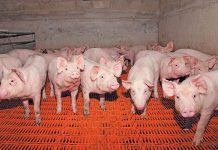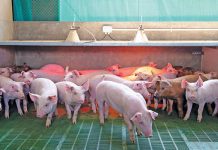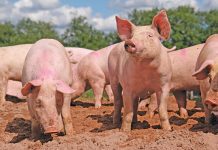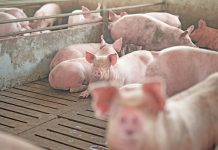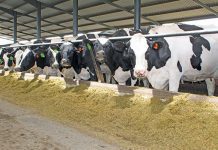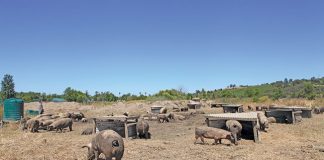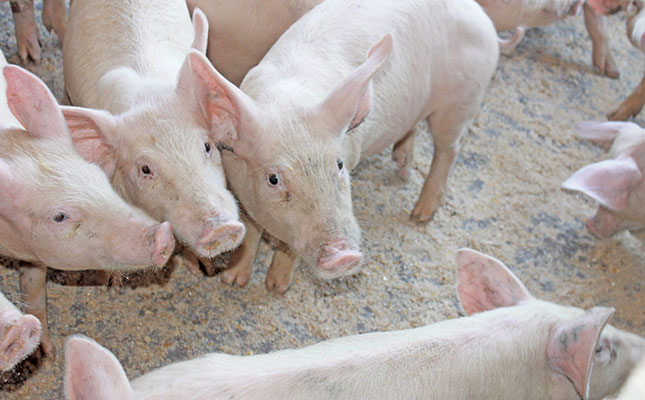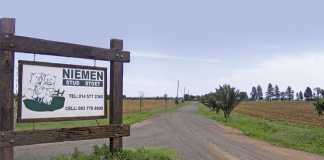
Photo: Nan Smith
In a secluded valley at the foot of the Langeberg Mountain’s Clock Tower subrange, 12km from Swellendam in the Western Cape, farmer Simon Goble is becoming part of the regenerative movement farming commercial Duroc pigs in this mainly winter-rainfall area.
Like many young farmers, Goble entered the agricultural arena armed with academic credentials in the form of a BAgric degree from Elsenburg.
READ Regenerative farming for livestock farmers
The academic environment teaches aspiring farmers much that is valuable, but leaves them with little practical experience.

After graduating, Goble spent a year working for a mixed grain, cattle and sheep operation, which went some way towards filling the experience gap and gave him the confidence to apply to work in the US, where he spent three seasons.
“I would encourage every young aspiring farmer to try and work in the US for a while. Salaries for farm personnel are up to three times higher than they are in South Africa, and food and accommodation are often thrown in. I was able to pay off my student loan and save enough to pay cash for a good bakkie when I got back,” says Goble.
In the very different environment and work culture of the US, he gained valuable experience, particularly in the mechanical field.
Choosing pigs
After a final season in the UK farming cereal crops in a heavy tillage system, Goble succumbed to the pull of home and returned to South Africa.
Limited by financial constraints, he saw pigs as a way of starting a farming business.
Andrew Ardington, farmer and founder of the Regenerative Agricultural Association of South Africa, offered him 1ha of well-watered land to get his operation going.
READ Selecting the right pig breed for your farm
Goble had already decided to farm the pigs on pasture as an improved and cost-effective means of producing pork after he read Joel Salatin’s work on pastured pigs. (Salatin is a well-known American farmer and author.)
“Pigs are the ideal small stock for start-up farmers with limited funds,” says Goble. “They can turn ‘waste into vleis’, and they reproduce so quickly. A sow can give me 16 piglets a year after losses.”
In November 2020, Goble moved into a caravan on site where he was to spend the next three years.
He bought in 10 two-and-a-half-month-old Duroc crossbred piglets, five gilts and five barrows (castrated male pigs).
Living close to his precious assets meant he could keep an eye on predator pressure and stock theft, both of which can literally steal the profit out of small-scale farming.
Ardington contributed another 10 young pigs and Goble bought a Duroc boar, Rocco, from Dr Josef Uys in Heidelberg, Western Cape.

“Rocco is a very good boar and the only guaranteed Duroc on my farm,” says Goble.
Duroc pigs are a good fit for a pasture-based system with shorter legs and a bullet-shaped, rather than a box-shaped, build.
According to Salatin, this shape makes for a mobile animal suited to walking and grazing on pasture. Durocs are known to be easy-care pigs.
Tough, and tolerant of climatic extremes, they do well outside, on grass, with simple field shelters for cold nights. Their meat has a high percentage of marbling, much like the meat of the Japanese Wagyu cattle, which makes for exceptionally tasty pork.
Start-up and production
In Goble’s first year there was no production, with only seven pigs slaughtered the whole year.
“To keep going I did whatever farm work I could get, like swathing wheat, packing bales and cutting fallen wattle and gum for firewood, which I bagged and sold in Cape Town. Firewood kept the bakkie full and our stomachs full that year,” he says.
But pig numbers grew and soon his Durocs needed more space. A further 3ha was granted by landlord Ardington, some of which needed clearing as it was overgrown with invasive aliens.
After its humble start, Goble’s business, Khula Farms, now runs 150 pigs with a core group of 20 breeding sows, 15 gilts and two boars.
Sows farrow twice a year and can deliver as many as 12 piglets at a time. Crushing of piglets is a problem and piglet mortality can be as high as 25% per litter, but this applies only to litters from older, bought-in sows.
READ Want to start a pig farm? Read this first!
“There is virtually zero crushing with sows I have bred here that have been routinely handled,” Goble explains.
He castrates because he keeps his pigs for six months, but says with some experience, castration of young boars is quick and easy.
He has not had to cull for replacement yet, but estimates replacement rates will probably be around 20% a year. Part of his welfare ethic will be to slaughter all breeding animals on farm when they are to be replaced.
Camps and fences
Pastures are primarily Paspalum urvillei, a grass native to South America, with other pasture grasses like clovers and ryegrass adding value to the grazing.
The pigs break soil capping and dig in their own manure, contributing to improving soil structure and fertility and making way for other plants.

The ‘smelly pig’ stereotype does not apply in a pasture system as the dung goes into the soil where it does the most good.
There are 22 camps in the pasture rotation, with camp sizes ranging from 100m2 to 1 000m2 depending on terrain and bush.
Pigs are run in groups of 10 per camp.
The pigs learn the value of avoiding the electric fence soon enough, according to Goble, who advises using a high-joule energiser that will deliver enough of a shock to stop pigs from breaking through the fence.
“We train them young so that they learn respect for the fence; once they are trained, they won’t test that wire,” says Goble.
He puts up two strand fences, with three strands between camps. Effective containment in the camps is important because pigs that escape can be rejected by their group if they aren’t reunited with them within 24 hours.
“Sometimes we have to build a separate camp for escaped pigs when their groups won’t accept them back. Escapees seem to accept one another.”
A good water supply is essential with pigs, and in this steep landscape Goble can gravity-feed water down into the valley where the pigs are.
On hot days, with temperatures rising to 40° and above, they must be constantly sprayed to help them keep cool. Wallows are not encouraged as the animals are moved from camp to camp.
Supplementary feed
Goble supplements pasture with barley and wheat sweepings, dairy waste, bread waste, leftover fruit and vegetables from nearby farms, and restaurant scraps from the town.
“It’s a hard job sorting through kitchen waste and you really need on-site freezer facilities to avoid dealing with maggots,” Goble explains.
“Now we use more whey, which we are lucky to get from a nearby cheese factory. We get the whey with no added salt, because salt in whey can cause dehydration and kidney problems. The whey has made a huge difference to the diet and our pigs are growing out really well on it,” he adds.
Apart from the whey, the pigs are fed whole milk, some of which Goble gets from a neighbouring farmer who gives him about 1 000ℓ of waste milk a week, adding a boost to the protein supply.
“It’s vital to build good relationships in your community. Farmers want to help one another. I helped my neighbour fight a fire and now he gives me 1 000ℓ of waste milk a week,” says Goble.
@farmersweeklysa Simon Goble of Khula Farm outside Swellendam feeds these three-week-old piglets in a small exclusion zone while their mother looks on. The sow suffered acute mastitis after farrowing. Her piglets were bottle fed until a few days ago and are now drinking happily from a small milk trough. #FarmersWeeklySA #agriculturetiktok #farmingsouthafrica #pigfarm #piglets #animaldiseases #mastisis #animalhealth #regenerativeagriculture ♬ Farm – Peppy Pals
The Khula Farms pigs enjoy a diverse diet with seasonally available fruit and vegetables that cannot be sold on commercial markets.
Goble picks up pumpkins, butternut, broccoli (seasonally dependent) and other produce from local farmers’ fields, and fruit from export fruit packhouses in the area.
This free, nutritious waste is a bonus to the small-scale pig farmer who needs only a bakkie and some labour to collect it. Class 3 barley and wheat at R1 800/t from SSK is another food source.
“A kind neighbour lets me use his hammermill, and I put it through twice to get the grain fine. I don’t mind a few weevils, but I won’t take anything wet, and I won’t feed anything even vaguely off to my pregnant sows,” he says.

The grain is soaked in water or whey before it is fed out. “At first, growth in the pigs was slow, but with ad lib whey we have a noticeable improvement in our growth rates. Feeding pigs can be a bit of a balancing act; when I gave them too much milk, I had to trim fat off the carcasses. I’m happy when they put on fat, but sugars lower protein. Whey has low-fat and positive protein, which is good for pork production.”
Goble aims to get his pigs to a 60kg carcass in a year, but says the added whey is giving him bigger pigs. His pastured pigs drop in condition during winter when they are using more energy to keep body temperatures stable.
Marketing
Khula Farms pigs are slaughtered when they are about 12 months old at a nearby abattoir and butchered by a local butcher before Goble sells the meat.
“There is no money in selling slow-growing pigs to an abattoir or a butcher, so I make the extra effort, pay the butcher and market the product myself. Owning your value chain increases your profit.”
He sells pork at the Swellendam Saturday market as a way of stimulating demand. And there is a healthy demand for pasture-raised pork, especially among a growing market of consumers who are health- and animal welfare-conscious.
The product is delivered locally and as far afield as Mossel Bay and Cape Town. Advertising is mainly by word of mouth, and news is spreading about the excellent quality of this Duroc pork.
Mentoring and the future
Goble is quick to acknowledge the help and advice he has had from other farmers, especially regenerative farmers Pietie Uys and Lindsay Hunt.
He has made good use of the Internet and through a Facebook group he met another mentor, Wisconsin farmer Ryan Kolodziej, who is always prepared to answer his queries.
His vision for the future is to grow by establishing more pasture-based farms, and to take his model to black emerging farmers in the Eastern Cape.
“I would like to teach people about using pigs on pasture to improve their soils and make a decent, sustainable living, and I think my model has exciting potential.”
Email Simon Goble at [email protected].



